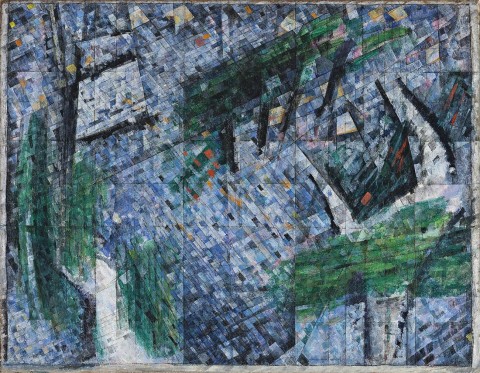SCENE BELOW, PADDINGTON, 1955 – 59
GODFREY MILLER
oil, pen and ink on canvas
35.5 x 45.5 cm
bears inscription verso: JH 43
Estate of the artist, Sydney
Mr and Mrs John Henshaw, Sydney
Charles Nodrum Gallery, Melbourne (label attached verso)
Private collection, New South Wales, acquired from the above in 2004
Thence by descent
Private collection, New South Wales
Godfrey Miller Memorial Exhibition, Darlinghurst Galleries, Sydney, 16 February – 27 March 1965, cat. 29 (as ‘Scene below Paddington’)
Godfrey Miller, Leveson Street Gallery, Melbourne, 12 – 23 September 1965, cat. 51
Godfrey Miller, Charles Nodrum Gallery, Melbourne, 2 – 28 September 2004, cat. 8 (illus. in exhibition catalogue)
Art and Furniture II, Charles Nodrum Gallery, Melbourne, 9 April – 2 May 2015, cat. 6
Henshaw, J., Godfrey Miller, Darlinghurst Galleries, Sydney, 1965, pl. 48 (illus.)
A visionary who rejected the materialism of his age, Godfrey Miller stands alone in the canon of Australian art with his meticulously executed, deeply cerebral works that invoke the simplicity of complexity to explore the unity of the universal, ‘… to capture a feeling for the essence of things in the perpetual flux of changing experiences’.1 Deceptively modest in scale, composition and technique, thus his paintings reveal upon closer contemplation an astounding breadth of experience – a mystic resonance that betrays the artist’s lifelong quest to embrace the subjective, transcendental Eastern philosophic experience with the more objective reason and logic of Western thought.
Born in Wellington, New Zealand in 1893, Miller began his career in architecture, studying at the Otago School of Art and Design before enlisting with the New Zealand Army upon the outbreak of World War I. Seriously wounded in action, Miller resumed his artistic studies shortly thereafter – first at the School of Art, Dunedin, and subsequently, at the National Gallery School, Melbourne and the Slade School of Art, London. Significantly, it was during this London sojourn that Miller became a determined, fully-fledged modernist, ‘call[ing] upon the shapes of planar and solid geometry for imagery, and [assigning] symbolic meaning there’.2 Although drawn to the exacting models of Cezanne and Picasso in his search for archetypal forms, Miller’s distinctive idiom was also indelibly influenced by his experience of traveling throughout China and Japan, as well as his anthroposophical pursuits3, and avid reading of authors as diverse as Plato, Goethe, Rudolf Steiner and Krishnamurti.
A domestic landscape inspired by Sydney’s urban environment, Scene Below, Paddington, 1955 – 59 offers a stunning example of this highly individualistic, geometric style gleaned from a rich array of formal and spiritual inclinations. Featuring the complex structure of Miller’s mature period, accordingly the canvas is intricately criss-crossed with hundreds of ruled vectors, minutely re-adjusted and re-aligned, to form a labyrinthine grid of innumerable small squares or diamonds of colour – thereby creating a shimmering mosaic or prism-like effect. If differentiated from his other Paddington paintings by the unusual perspective here – looking down from the first floor, a viewpoint evoking both an uneasy tension and sense of intimacy – ultimately however, the scene conveys very little sense of the experience of modern city living, imbued rather with a detached passion reminiscent of Paul Klee. For Miller indeed, the external environment was merely the visible emanation of the invisible forces of Nature – a ‘symptom’ to be first recognised and understood, before then elevated from the mundane to the arcane, from the ordinary to the extraordinary. In a manner echoing his own self-effacing nature, Miller thus gradually pared back his subject (often over the course of years or even decades) to its very essence where ‘natural appearances are never entirely eradicated, being held as it were in flight between interpenetrating grids …’4 in order to establish a new reality –one rooted in a deep symbolism and anthroposophical mysticism, ‘… made of cadences, rhythms, intervals, chords, qualities – all that science ignores’.5
A shy, contemplative figure, Miller deliberately eschewed publicity and the machinations of the art establishment, notably choosing not to exhibit his work publicly until the final decade of his life; as he poignantly mused, ‘I don’t want competition with my fellow humans. I happen to be one of those who work best, or can work at all, right outside the competitive element. I do not want to struggle up to carry things through … It is a matter of subsiding at the heart of things’.6 Notwithstanding such reticence, fortunately Miller today occupies an unrivalled place in Australian art – his legacy represented in most major public and private collections throughout the country, and abroad, at the Tate Gallery, London.
1. Smith, B., Australian Painting 1788 – 1970, Oxford University Press, Melbourne, 1971, pp. 302 – 303
2. Wookey, A., ‘Godfrey Miller and Mathematics’ in Edwards, D., Godfrey Miller 1893 – 1964, exhibition catalogue, Art Gallery of New South Wales, Sydney, 1996, p. 111
3. Miller joined the Sydney Anthroposophical Society in 1940, and found particular affinity with the teachings of German esoteric Rudolf Steiner, who sanctified the role of the artist as ‘bringer of the Divine to Earth’.
4. Smith, op. cit., p. 303
5. Miller quoted in Edwards, op. cit., p.56
6. Miller quoted in Edwards, p. 80
VERONICA ANGELATOS
